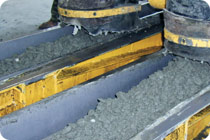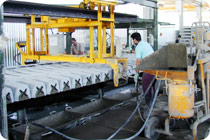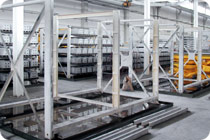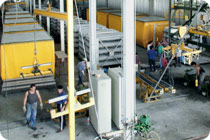|
 Manufacturing system with utmost flexibility Manufacturing system with utmost flexibility
Thanks to the limited number of moulds required, the DSA process offers utmost flexibility. Conversion for different sleeper
types or rail fastening systems is carried out in the shortest time. Because the sleepers are prestressed after the concrete has cured (post-tensioning),
the sleepers can be moved to an interim storage magazine until the concrete has cured to the necessary compressive strength.
 The manufacturing principle The manufacturing principle
When casting the sleeper, die rods are used to form the channels for the tensioning tendons.
When the sleeper has cured, the tendons are inserted into the channels, and tensioned.
Thanks to the prestressing method (post-tensioning with positive anchors),
the high pretension is maintained practically without reductions during the sleeper's entire service life.
|
Survey of the advantages:
|
- Outstanding product flexibility
- Production can be changed to a different sleeper or rail fastening type within the shortest time
- Fast response to varying market demands
- Low space requirements
- Low investments
- Minimized set-up costs
- Expandable automation stages
|
 Manufacturing options using the DSA process: Manufacturing options using the DSA process:
Slab tracks
Standard rail sleepers
Sleepers for craneways
|

Fillig the twin-moulds |

Injection into the post-tensioning duct |

Dry storage with climatic basins |

Dry storage with climatic hoods |
|





